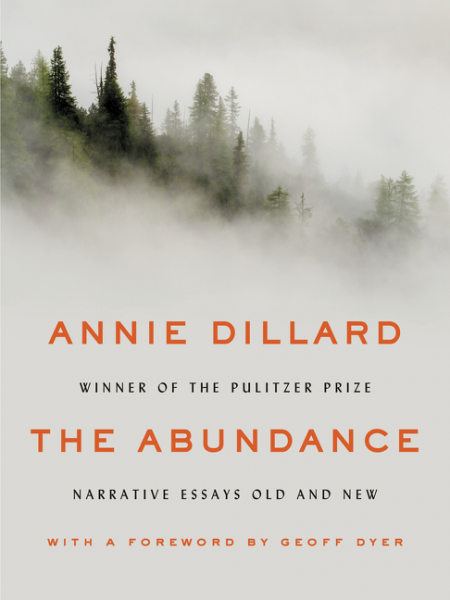The Abundance
by Annie Dillard
reviewed by Eric Stinton
The worlds of fiction and nonfiction tend to be considered opposite sides of the same literary coin. It is a strange sort of division, one that separates bookstores and Greek philosophers alike. Yet as seamlessly understood as those categories may be, there is something crude and inexact about them; languages outside of English often need to invent words to distinguish what is simply known as “storytelling.” Indeed, telling a good story in either fiction or nonfiction requires access to both the real and the imagined.
Those creases between reality and imagination are exactly where Annie Dillard, winner of the 1975 Pulitzer Prize for general nonfiction, has made a home. Dillard doesn’t blur the lines between fiction and nonfiction so much as occupy them simultaneously, deploying the surreal and sacred into the cracks of her experiences like glacial rivulets until they frost-shatter into dreamlike prose. The result is a pioneering presence in the literary world that has spanned decades. With The Abundance, Dillard offers readers old and new a curated bird’s-eye view of her essays from 1974 to 2005.
To pin Dillard down as a nature writer is obvious and easy, but it also misses the point. In the opening essay, “Total Eclipse,” the celestial event is compared to a nuclear mushroom cloud. What should be a moment of astounding beauty becomes a vortex of horrified awe and existential rumination, and yet she does not avert her eyes. Rather, direct and courageous confrontation reveals the true beauty of the experience, and those feelings of “violence and terror of which psychology has warned us” ultimately give “goodness its power for good, and evil its power for evil.” In the midst of physical phenomena, her focus is always directed toward the eternal.
Dillard is at her best—or at least her most comfortable—when her writing connects nature and the worlds above and within it. She does this by piling simile upon simile; although the individual comparisons are seemingly incongruous, together they manage to achieve precision. In “Waking Up Wild,” Dillard answers her own deceptively simple question—“What does it feel like to be alive?”—by reeling off perfectly apt, if somewhat scattered, descriptions: “Knowing you are alive is watching on every side your generation’s short time falling away as fast as rivers drop through air, and feeling it hit. Who turned on the lights?” A paragraph later, she continues: “Knowing you are alive is feeling the planet buck under you—rear, kick, and try to throw you—while you hang on to the ring. It is riding the planet like a log downstream, whooping.”
The repetition of river imagery connects the very different yet equally true concepts of what life is, that sentient helplessness realized abruptly, as if someone had turned on the lights. It is the type of metaphorical progression that earned dubious praise from Eudora Welty, who said that in spite of Dillard’s undeniable talent, “I honestly do not know what she is talking about at such times.” No matter; it doesn’t have to make perfect sense, so long as it rings true.
The pursuit of truth, in its many forms, is at the heart of Dillard’s writing. The emphasis there is on the word “pursuit”; Dillard is wont to wander, and the exploration is almost always more significant than the discovery. Through her meanderings she extracts the personal from the expansive and finds the mythopoetic in the minuscule. Childhood mischief is the source of nostalgic glory, a moth engulfed in flames is heroically funerary, and the visage of a deflated frog is a moment of enlightenment. With enough patience and earnest inquiry, anything and everything is of supreme import.
The Abundance no doubt saves the best for last. In her closing essay, “An Expedition to the Pole,” Dillard bounces between a folksy New Age Catholic mass and the hilariously doomed nineteenth-century polar voyages. The crux of each storyline is a haphazard search for the most remote conceptions known to man. As the music crescendos in the church halls and ill-equipped adventurers stiffen to frozen statues, the two worlds collapse into each other in comical phantasmagoria. It is absurd, profound, and quintessential Dillard.
Dillard is both a transcendentalist philosopher and a scientific theologian, whose wit and wisdom are as relevant today as they were forty years ago. She doesn’t simply grapple with the Big Ideas, she lets them pin her down so she can study their underbellies; she folds, twists, and bends to see them flex and contort under various strains. The Abundance is both a highlight reel and a victory lap. It has a retrospective “Greatest Hits” quality that seems to support the rumor that Dillard may in fact be finished with writing for good. If so, she has left us an abundance, and while there is plenty to be grateful for, it is hard not to want more.
Published on November 4, 2016

